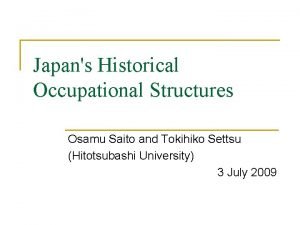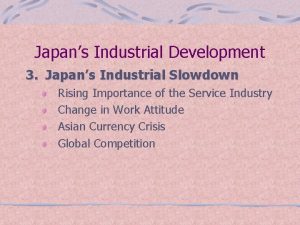Japans Historical Occupational Structures Osamu Saito and Tokihiko















- Slides: 15

Japan's Historical Occupational Structures Osamu Saito and Tokihiko Settsu (Hitotsubashi University) 3 July 2009

INCHOS n n The international network for the comparative history of occupational structure (INCHOS) was launched in late 2007 by Dr Leigh Shaw. Taylor (HPSS, University of Cambridge) and Professor Osamu Saito (Hitotsubashi University). This followed on from a session at IEHA’s Helsinki meeting in 2006 and a very successful workshop on occupational structure hosted by Hi-Stat at Hitotsubashi University in September 2007.

The aim of INCHOS n n To develop a genuinely comparative history of occupational structure by using a common occupational coding system and common methodologies to ensure commensurable results. Our interest is not in a particular period but on the long-run process of industrialization which means that the focus is on different time periods in different countries.

INCHOS 2009 n Conference in Cambridge: King’s College, 28 -31 July n Countries covered: England; Belgium; Germany; France; The Netherlands; Italy; Spain; Bulgaria; Japan; Taiwan; India; Indonesia; Russia; Sweden

An initial set of issues n n Coverage: census and pre-census periods Classification problems: PST system Primary Secondary, including mining Tertiary Problem of ‘labourers’ in early censuses

Con’d n Female employment Pre-census data: e. g. baptismal register Censuses: changes in ways in which female and child labour was recorded n By-employment Individual When principal employment only, industrial and other forms of non-farm employment may be understated Household

Some broader issues n England’s early modern and modern growth Manufacturing employment grew in early modern times more substantially than in the classic industrial revolution n Tertiary sector England: its growth more striking than that of secondary employment during the classic industrial revolution Belgium: a similar growth pattern now emerging from new estimates

Con’d n By-employment Implications for sectoral labour productivity growth Sectoral gaps in earlier phases may well have been smaller than previously thought n Institutional factors: India’s caste system could be associated with a greater division of labour in the Smithian sense but acted as an obstacle to further divisions between intermediate and finished products

Our paper n Focus on by-employment Farm family by-employment widespread in the latter half of the Tokugawa period. The pattern could be inverse-U shaped. n National income estimates When the existence of subsidiary workers is taken into account, to what extent will the existing national income estimates be affected? n And patterns of sectoral productivity gaps?

A tentative attempt: with earlier LTES data and coefficients derived from 1879 Yamanashi cross-tabulations

Assumptions 1870 s Primary L(P)*0. 82+0. 5*(L(P)*0. 18+(L(S)*0. 38+L(T)*0. 02) Secondary L(S)*0. 61+0. 5*(L(S)*0. 39+L(P)*0. 11+L(T)*0. 01) Tertiary L(T)*0. 97+0. 5*(L(T)*0. 03+L(P)*0. 07+L(S)*0. 01) 1925 Primary L(P)*0. 9+0. 5*(L(P)*0. 1) Secondary L(S)+0. 5*(L(P)*0. 0667) Tertiary L(T)+0. 5*(L(P)*0. 0333)

By-employment and proportion primary: pooled district-level data in 1879 and 1925


Estimates of principal-equivalent gainful workers in PST sectors n n Tertiary: Settsu estimates Secondary: Will see if the same model works For this sector, net output readily available n Primary: as residual

Actual paths in sectoral productivity growth n n The initial gaps in labour productivity between ST and P Did the ST-P gaps increase or decline over the entire prewar period?
 Osamu saito
Osamu saito Appstami
Appstami Saito token
Saito token Japans educational system
Japans educational system Japan government type
Japan government type Japans physical geography
Japans physical geography How did prince shotoku unify the japanese people?
How did prince shotoku unify the japanese people? Nara meaning japanese
Nara meaning japanese Xxxx japans
Xxxx japans Japans geography
Japans geography Japans isolation
Japans isolation Human arm and whale flipper function
Human arm and whale flipper function Williams-steiger occupational safety and health act of 1970
Williams-steiger occupational safety and health act of 1970 Occupational therapy and environmental sustainability
Occupational therapy and environmental sustainability Role of community health nurse in occupational health
Role of community health nurse in occupational health Occupational health and safety act 1984
Occupational health and safety act 1984





























